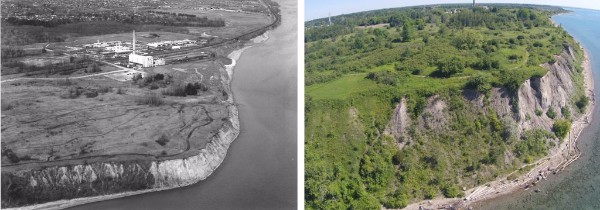As one of Toronto’s natural wonders, East Point Park is known for its stunning views of Lake Ontario from atop the Scarborough Bluffs and for an abundance of birdwatching opportunities. Yet many might be surprised to learn the park was not always the natural area that we know today.
East Point Park has enjoyed an interesting past. During the 1800’s, the land was privately owned and undeveloped. While some land was transferred to the Township of Scarborough in 1911, by the 1950’s more parcels were purchased by private industrial companies. By 1974, these former industrial properties were transferred to Toronto and Region Conservation (TRCA, then MTRCA). Today the land at East Point Park is owned by TRCA and managed by the City of Toronto.

Since taking over the ownership of East Point Park land, TRCA has taken steps to restore the site to a more natural state. This work has entailed soil remediation and planting of native vegetation, however, much of the changes that have occurred are due to nature itself. What we see today is actually the result of natural ecological succession – the process by which plant communities change over time.
This sassafras, surveyed at the #Scarborough shoreline, is the furthest NE record of this #tree in Toronto & region! pic.twitter.com/pFGFoqe9Hf
— TRCA Monitoring (@TRCA_Monitoring) September 8, 2016
As a result, suitable habitat has been created for many animal species that weren’t found there previously. A few decades ago, White-tailed Deer were rarely seen in this area, but now they are common. There has also been an increase in the population of Eastern Coyotes as well as migratory birds. The growth of species to observe, paired with the popularity of birdwatching has made East Point Park a place to treasure and protect.
8 out of 8 bat species in #Ontario found by @ROMBiodiversity at the #Scarborough Bluffs! https://t.co/ynMyJxZADP pic.twitter.com/EZPYY8zQj4
— TRCA News (@TRCA_News) September 16, 2016
Torontonians and visitors are discovering East Point Park in increasing numbers. While it is important for people to be able to view and experience nature, allowing unfettered access can eventually result in the degradation of natural habitat. Over time, the expansion of an informal network of trails which divide larger tracts of valuable habitat increases disturbance to plants and animals and promotes the spread of invasive species. Failure to adapt to the increasing number of visitors would ultimately lead to the decline in the ecological integrity of East Point Park.
Touring East Point & learning about the Scarborough Waterfront Project w @RenewScarboro & @WaterfrontTRCA #ScarbTO pic.twitter.com/WlwxMhuKY3
— Arlen Leeming (@ArlenLeeming) September 27, 2016
TRCA and the City of Toronto have extensive skill and experience managing natural areas within the urban context. As partners, they’ve concluded the best way to facilitate access while protecting the natural environment is to decommission informal trails and consolidate access along a formalized trail system. The Scarborough Waterfront Project offers a wonderful opportunity to accomplish this.
[advanced_iframe securitykey=”b846dca6faa2d4c5cdfef39ad6176d03cf94a66b” use_shortcode_attributes_only=”true” src=”https://www.youtube.com/embed/IsJ4LC0yaxM?rel=0″ frameborder=”0″ allowfullscreen=”true” content_styles=”width:100%” width=”100%” enable_responsive_iframe=”true” iframe_height_ratio=”0.5625″]

